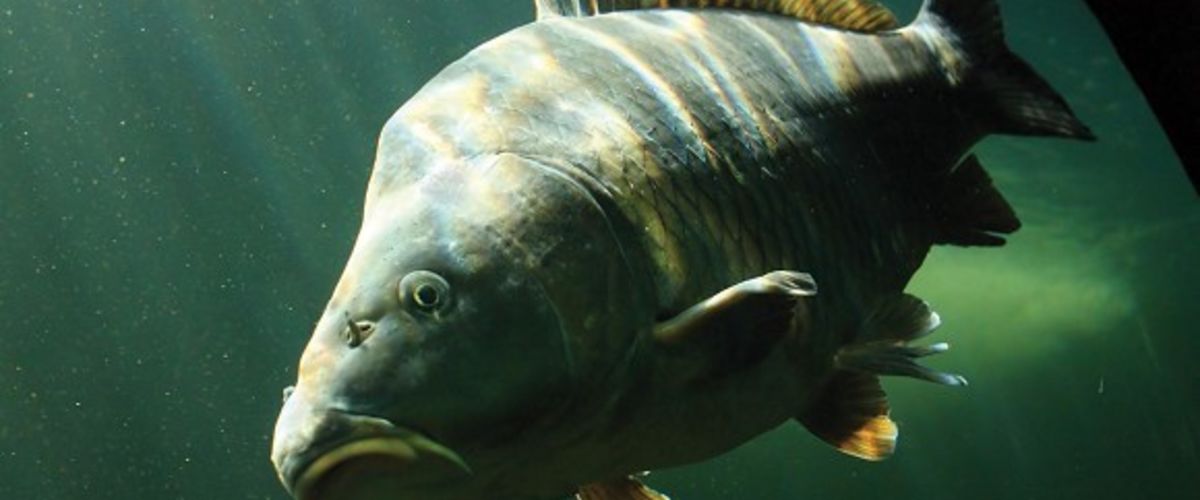
The unassuming zig
Finally: a zig rig article with a difference thanks to Ash Haveron's seven-year's experience using them
There is one method I have found can buy you a bite at any time of the year, particularly during the winter and early spring and that’s the humble Zig Rig. In my eyes, it is one of the most devastating, instant (when used correctly) and exciting tactics there is to catch carp. However, I think it is a very underused and misunderstood method which a number of anglers occasionally explore and others avoid completely.
Now, there are whole periods of time when carp are just not interested in the bait we are using to try and catch them. There are obviously numerous reasons for these periods of inactivity such as the weather for example but more importantly I think it is down to their preoccupation on the natural food sources. It is during this time that I have found Zigs can outshine, or shall I say, ‘buy you a bite’ above anything else. I have lost count of the number of times when I have fished a Zig, even on one rod, and it has saved me a blank.
Within this article I will try to explain my thinking behind Zigs and hopefully give you a few things to consider based on my experience over the past seven years of proactively utilising this method into my own fishing.
Naturals and location
As with standard bottom bait fishing, location is essential for Zigs. First and foremost, topping fish is the biggest sign I am looking for. Now, when I say topping fish I mean carp turning or splashing on the surface. On occasions this can be very blatant with huge crashes on the top, however on the other hand it can be the slightest of rolls. In my mind both scenarios indicate to me that the fish are on the naturals which are travelling through the layers and it is worth trying a Zig. I recall a winter’s session on Monks Pit in Cambridge. The conditions were cold, overcast with a slight wind and I hadn’t seen a single thing during the first 24hrs of my stay. Then, during the second morning I caught a glimpse of what I thought was a gentle roll on the surface. I initially thought it was a big rudd or even a pike but I thought it was worth a rod on it. So I cast out a Zig and within the remainder of my stay I had five carp – three of which were over 30lb from that one spot.
To me, the most interesting part of Zig Rig fishing is trying to understand the theory behind it. Why does it work and when could it work? Have you ever sat at the water’s edge and noticed the swarms of midges around? Now these little buggers are from the lake or river you are next to and are one stage of the life cycle of a bloodworm which is the predominant natural food source for most freshwater fish including carp… so here comes the scientific bit! The hundreds and even thousands of midges (mosquito-like in appearance) you see around or above you are actually mating with one and another. During this ritual the adult females will lay their eggs by skimming the water’s surface in flight. Now these eggs are not individual ones, in fact they are stuck together in their thousands which give them the added weight to help them sink to the bottom. The next stage of the life cycle involves the midge larvae leaving the egg which subsequently bury themselves in areas of silt or purpose-built tube-like structures in which they live. During this time in situ they grow on organic matter in the water until the larvae becomes pink and eventually dark red and then, ‘hey presto’ we have a bloodworm! Now during a period of weeks after entering this stage, the bloodworm will transform to a pupae state, a bit like how maggots turn into casters really. After a few days, the pupae will rise to the surface and will eventually emerge as a midge.
Now, it is during this stage when the pupae or ‘buzzers’ are going through the surface layers that Zigs can be absolutely devastating and this is when you will see the carp splashing or rolling on the surface as mentioned above. Observation is therefore key, so first and foremost it is this ‘activity’ which I am looking for as it takes the hard work out of finding the silt pockets where the buzzers may eventually hatch from. But more importantly, where the carp WANT to be! I cannot emphasise this enough when it comes to Zig Rig fishing.
If the carp are not visibly showing these signs then I will search for these bloodworm beds. Areas of silt on the edges or ends of bars are a good starting point but do not ignore gullies or slight depth variations such as humps or plateaux where the bloodworm will congregate at the base of these features. However, look at what is occurring in front of you: silver fish such as roach or rudd etc. hitting the surface, flocks of seagulls gathering in one area, ducks feeding on the surface and even where grebes are will indicate areas of these natural larders. It is a food chain which both aquatic and birdlife will all capitalise on. Alternatively, during the warmer months, the tops of relatively shallow gravel bars (3 to 5ft) can be a devastating area to position a Zig as these will be patrol routes the carp will follow.
When it comes to the weather, I have caught carp on Zigs in all different types of conditions. From hot sunny days to freezing cold winter nights, in rain, strong winds, fog and even snow. However, one determining factor which I always pay attention to is the atmospheric pressure. It is suggested by many that changes in atmospheric conditions are felt or sensed by most fish including carp via their swim bladder. Over the years talking to like-minded anglers and reading lots of material on this subject, the general consensus is that when there is high pressure carp will spend much more of their time in the mid- to upper-layers. This is particularly relevant on deeper waters as during such conditions, the force of pressure closer to the lake’s bottom can cause discomfort to carp via their swim bladder. PLEASE NOTE: this is not the gospel and I know of plenty of guys who have caught loads of fish in high pressure conditions on the deck in deep areas. However, if I look back over my catch records on Zigs; I would say 80% of them have been when the pressure has been above 1005mb.
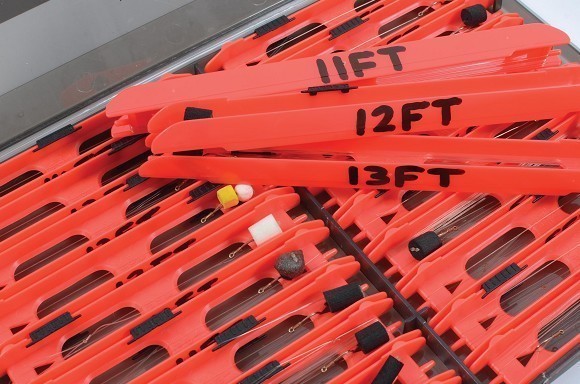
My ready-tied Zig hooklinks – every depth is covered!
Rig mechanics
So to fish a Zig Rig you need to present your chosen hookbait in the mid- to upper-water layers. Now there are a number of tactics you can use to achieve this. Variable or Adjustable Zigs are certainly a devastating tactic and a number of manufacturers now sell Adjustable Zig Kits which are very good. However, I like to keep things as simple as possible and from my experience the fewer components I have on the line and the more direct contact I have with the fish the better.
I want to get as close to matching my hookbait with the natural invertebrate as I can. That’s why I opt for hookbaits such as small pieces of foam and 10 to 12mm whittled down pop-ups. Therefore, I like to use small hooks: size 8 Drennan Super Specialist is my chosen pattern. They are incredibly strong and sharp with the hook points kept short which in my mind eliminates movement in the fish’s mouth and ultimately less hook damage. I always tie on my hookbaits via a standard Knotless Knot. I have tried attaching pieces of foam or boilies directly onto the hook but have found the hook holds to be inferior to normal Hair-rigged baits and I’ve lost a number of fish. My preferred hooklink is Drennan Double Strength; it is cheap as chips, tangle-free and exceptionally tough for its diameter.
Now with small hooks such as the above I don’t want a lead weight or anything else bouncing around up the rig, especially on long hooklinks. Over the years I have experimented with numerous methods for Zigs and what I have found is that by losing the lead, you have a greater chance of landing a fish. Therefore lead clips are for me the best component to use for Zigs. However, I need to be 100% sure that the lead will drop-off when it needs to. I cannot emphasise the difference in the fight and probability of successfully banking a fish between the lead still being on and not, especially with hooklinks 6ft and above! Furthermore, if you are unfortunate to crack-off on the cast (let’s be honest it occasionally happens from time to time) or you get cut-off whilst playing a fish, then I DO NOT want a fish towing around a long hooklink with a bloody great big lead a few feet behind it!
My lead clip arrangement has evolved somewhat over the years. I initially started with a standard clip with the tail rubber gently pushed on, however I found the success rate of losing the lead was very low and during a period of four months in the spring of 2009 I lost a number of fish and some real good ones too… something needed to change! Consequently, I removed the tail rubber element completely and replaced this with a small piece of silicone tubing. Now this did seem to improve things but it wasn’t perfect and on occasions it was inconsistent. To further complicate matters, I then had the added issue of the lead occasionally coming off on the cast!
On a visit to see Dennis at the MCF factory back in 2010, I was introduced to what I now consider to be an absolute revelation to not only my standard bottom bait fishing but more importantly my Zigs… and that is the MCF Dumper Lead Clip. In my opinion and lots of other anglers who have used them, they are without doubt the BEST and SAFEST lead clip on the market. The design of the ‘Dumper’ is just so simple and with its unique composition, allows the lead to be ejected immediately on the initial take which is essential on weedy or snaggy waters. Even more exceptional is that you will not lose your lead on the cast, nor when retrieving through thick weed regardless of the size of your lead. From a Zig Rig perspective, it is perfect and over the past two years has completely transformed my approach but more importantly, the number of fish I have successfully landed!
A sneaky tip if you are fishing extreme hooklinks such as 12ft and above. Place your lead onto the tip of the bar on the Dumper and gently bend the wire arm outwards. This effectively makes the Clip even more sensitive… a roach has only got to fart and the lead will drop off! However, to prohibit any unwanted tangles I flatten a piece of PVA foam and wrap it around the Dumper just in case. Whilst we are on the subject of very long Zigs, the beauty of the Dumper is that you can actually reel it through the eyes of your rods when the fish is ready to be netted. Trying to net a fish on extreme hooklinks can be a nightmare, but with its streamlined design it just makes it so much easier. However, a word of caution, make sure the fish is definitely ready for the net before you attempt this!
When it comes to choosing my leads, my preferred choice is either a pear or distance variation in 3.5oz. This enables me to cast to those spots further out but more importantly, provides enough credence to set the hook firmly in the carp’s mouth when you get a take. Again, this is crucial when using longer hooklinks.
What depth to fish a zig?
Now, this really is down to observation and if you can see signs of fish as described previously you are 50% on the way to making a Zig work for you. However, if you are fishing blind then there is a general rule of thumb I would follow.
During the warmer months, I always start by fishing my Zigs 2ft below the surface. However, during the winter and early spring I always begin with my rigs being positioned mid-water. So if I was fishing in 10ft of water I would initially try a 5ft Zig. The great thing about this form of fishing is that you can keep active by experimenting with different depths and areas to fish until you get a take – i.e. keeping with the example of 10ft of water in front of me I would stagger each rod: 4f, 6 and 8ft or other variations until I locate the depth the fish are at. If you are fishing with a friend in the swim next-door then you can work as team, trying different depths until you find the correct length of Zig to use.
To enable me to change the lengths of my hooklinks quickly, I pre-tie mine. Now I know this is a little bit sad and slightly OCD but I do not want to be messing around tying up new rigs when I want to change the depth my Zig is fished at. Each hooklink is finished with a loop which simply attaches to the MCF Dumper Clip with no problems… simplicity itself! This storage system also allows you to pack your hooklinks away quickly and safely, rather than leaving them hanging in trees which is dangerous to bird life. I have lost count of the number of times I have turned up in a swim and found ‘left behind’ Zigs… bad angling.
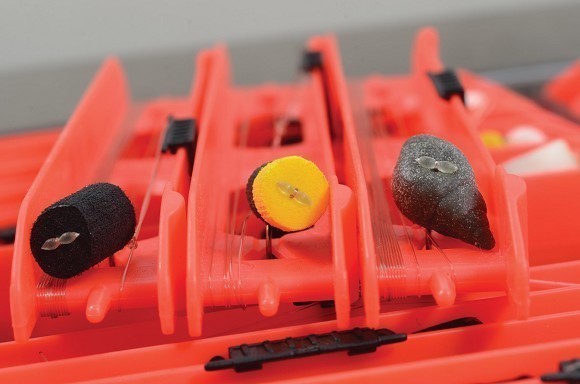
A selection of foam Zig hookbaits
Chosen hookbaits
For me, this is the most intriguing part of Zig Rig fishing. Why on earth would a carp want to eat a tiny piece of foam or a pop-up suspended in mid-water? They do and the biggest hurdle you have to conquer is getting your head around it. I remember talking Zigs with a guy on Monks Pit one spring afternoon and he just couldn’t understand why they would work. The following morning I had ‘Her Majesty’ in the net at 35lb, a fish which hadn’t been caught for two years. He did make me laugh when I told him!
Without doubt, small pieces of foam have been the most successful hookbait for me over the years. I have tried everything (and I mean everything) but the foam has always come out on top. I think it could be down to its buoyancy but what I like more than anything is its versatility when shaping your preferred hookbait. I don’t flavour mine, it’s a personal thing really but I know plenty of chaps who do and have had awesome results. In my opinion it’s just another thing for the carp to think about. The colour black is most definitely my favourite and successful, however I have also done particularly well on yellow and even white. Strangely, I have had a number of fish on white bits of foam when there is a full moon and particularly in winter. I’ve also had some good results on a piece of black foam tipped with a piece of white foam. The inspiration behind this came about following a discussion with Dennis McFetrich when he showed me the flies he uses for his fluff chucking (fly fishing). The flies he had tied were a buzzer pattern with black bodies and a small piece of white material on the bend of the hook. This was an imitation of a hatching bloodworm (buzzer) and the white component represented the air pocket they use to travel through the thermal layers.
When it comes to using ‘proper’ hookbaits, then 12mm pop-ups have always scored well for me; especially when you are spodding soup mixes over the top. It is important to note, however, that carp will take or shall I say inspect anything which is suspended in mid-water. They are naturally inquisitive creatures and I believe any hookbait will work when you are ‘opportunist Zig Rigging’ or ‘chucking it and chancing it’, especially in the warmer months. However, when the fish are really on the hatching naturals you can fish Zigs in an effective and methodical approach. This is when in my experience pieces of foam out-fishes anything else.
As I’ve mentioned already, winter and early spring in particular are an awesome time for Zigs. So much so that there have been occasions when I have turned up to a lake with not a single boilie on me – not even a pot of pop-ups. This takes some confidence but trust me, it is worth it. You just need to look at the capture of the Big Common from Monks Pit by Dave Lane a few years ago. Now this particular fish was only caught once or twice a year but Dave had it on a Zig in February when the conditions were horrendous… a week after the lake had been covered with a thick layer of ice if I’m correct. In my opinion an awesome piece of angling.
Creating attraction
Creating a feeding situation or area of interest for carp on heavily stocked waters can be a devastating tactic. Over the years I have tried numerous ‘soup’ mixes incorporating such ingredients as milk powder, evaporated or coconut milk, crushed hemp, liquidised sweetcorn to name but a few. This is always mixed with lake water from the venue I am fishing which is consequently spodded over my hookbaits to create an appealing cloud.
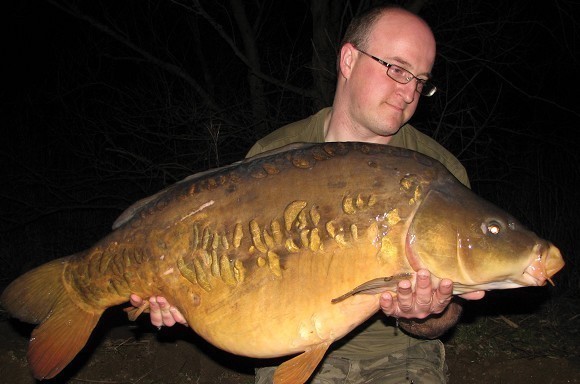
‘Her Majesty’ in all her glory
Bite indication
This is a very interesting topic when it comes to Zigs and varies from one angler to the next. I’ve seen some guys who fish very tights lines to those who prefer totally slack presentations. Now the latter is not for me. I would say that 90% of my takes on Zigs are absolute screamers, however I’ve had lots of takes which have been drop-backs. I think the main contributing factor to this is the lead clip arrangement. As soon as the fish is hooked, the lead is released and effectively the fish is then on a free line. Bite indication is therefore key as once the lead is dropped, there is the possibility the fish can kite in any direction; to your left or right and even towards you. In my opinion, fishing slack lines is effectively pointless and you wouldn’t have a clue what is going on! This is when the Rattler bite indicator system comes into its own. Any movement of that lead or hookbait in any direction is accentuated. It provides you with proper bite indication and this is what I am looking for as the bites on Zigs can sometimes be very odd.
I remember a session on Monks Pit in 2011. I was fishing one of the deeper swims on the lake and during the first morning of my stay there were a number of fish showing – clearly on the naturals and hitting them while they were emerging through the layers. The depth around this area was around 14ft and although the fish were occasionally rolling on the surface, I suspected they were feeding more in the lower- to mid-layers, so I opted for a 6ft hooklength with my usual piece of black foam. Out it went and within 15 minutes I had the slightest of drop backs on my Rattler. On picking up the rod and after an epic battle there was a 35lb 12oz mirror in my net. Again, with the wrong presentation and indicator I would have never known this particular fish had slipped up!
Casting a zig
When I’m talking to friends and even customers at the shows, this is the one question which comes up time and time again when discussing Zigs. How do you cast a Zig without it tangling? I think first and foremost in my opinion it comes back to keeping things simple and as I have already mentioned, the Dumper Clip illeviates 90% of tangles. However, in addition to this you need (on entry to the water) to feather your line to ensure the hooklink and bait kicks back behind the lead. I have found on many occasions if you don’t do this, there is a good chance you create a right old mess out in the lake which is just not the presentation you are looking for. Again, this is particularly important with longer hooklinks.
When casting longer hooklinks out and depending on the swim I am fishing, I try to avoid clumping the hooklink all in one spot on the ground. I place my hookbait on the ground (further back from the water’s edge and my eventual casting position) and then walk forward so I achieve a nice straight curve in the line. I have found this also helps with tangles and achieving those further distances.
Again, depending on the nature of the swim you are fishing, laying your hookbait on the ground for casting can be tricky especially if there is debris or foliage such as long grass, twigs etc. around. To get around this, my Jack Russell’s water bowl (or such like) is perfect. I fill it with water; lay the hookbait on the surface and cast out. This is a 99% foolproof way of avoiding getting caught up with bushes, reeds, branches and even your bivvy!
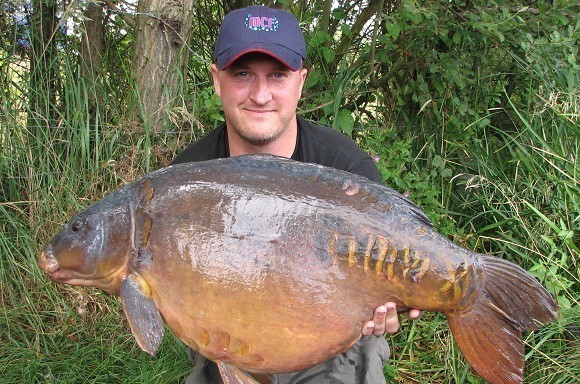
A 35lb stunner thanks to the Zig Rig
Fish safety
This is a subject that I am passionate about in all fishing situations and tactics, but especially when fishing with Zig Rigs. Zigs have most definitely grown in popularity and unfortunately this has resulted in a number of waters banning them due to improper use. The main objective for this has been due to the breaking strain of line some anglers choose for their hooklinks. As I have already stated within this article, my chosen hooklink material is Drennan Double Strength. The minimum breaking strain I use is 15lbs which to most sounds a bit excessive, however, the fight on Zigs can be epic and the initial take brutal. Hence, you need a hooklink which is up to the job. I’ve seen on a number of occasions guys using 8, 10 or 12lb line which in my mind is crazy, especially on weedy waters. I believe their theory behind this is that the fish will see the thicker diameter hooklinks. However, I don’t agree with this for two reasons. Firstly, the majority of fish I have caught on Zigs are hooked bang in the centre of their bottom lip. This to me signifies they are dropping down to pick up the hookbait, hence how would they see the hooklink? Secondly, when the fish are really preoccupied on the hatching invertebrates such as bloodworm they couldn’t care less what was in their way!
I recall a mad 2hr display at Suffolk Waterpark a few years ago. The fish were so preoccupied on the naturals that when I cast out my marker float to judge the depth, they were crashing all around it. I even had one land right on top of the float itself!
The above also applies to your main line. In some instances and of course depending on the water you are fishing, you may need to give it the big ‘un and get your Zig out 100yds plus. Again, do not be tempted to opt for weaker breaking strain lines. If you crack-off not only have you left a long hooklink out in the lake but also a trail of main line. I tend to steer clear of fluorocarbon for Zigs and stick with good quality standard monos.
And the summary...
To conclude, I hope the information I have detailed within this article has convinced you to try Zigs with a little more gusto, especially during winter and early spring. It really is a devastating tactic and when used correctly can turn a ‘blank’ into a session of a lifetime. Don’t be misled into thinking that only small carp can be caught on Zigs – this can’t be further from the truth and I just wish I could document some of the huge fish some of my friends and I have caught using this method. Trust me, it takes a lot of confidence to cast out a small piece of foam out into the abyss but once you have landed that first fish, you will be hooked!




